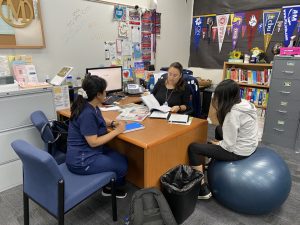
by: Jordyn Tribus
College applications are known intimidators for high school seniors. When starting your process it may seem like there are a ton of different actions you must do, but if you learn more about the steps, things become a little bit easier. The main parts to know, that will be introduced respectively, are the basics, stress factor, filling out the application, the essay, major takeaways, and advice. If you are still lost please contact Mrs. Tidball or any of our school counselors.
Basics
As the year starts, incoming seniors and juniors are advised to start thinking about college and the best course of action to apply. When creating your list you must keep in mind the number of schools you want to apply to and the distribution of reach, match, and safety school (and of course looking for your major and what you want to study, but that is yet to be discussed). When starting your list, hopefully during your junior year, it is good to have a wide variety of choices, but as you get closer to your senior year and the application due dates, you must decide on your top five to seven colleges. Out of these schools, you should have an even balance of reach, match, and safety schools. Safety schools are colleges that you are almost guaranteed to get into; even if all else fails, you will be going to college. A match is everything you want in a reach school but is more financially attainable either through scholarships or financial aid. Reach schools are more prestigious and any school that has under a 20% admissions rate, regardless of GPA.
“I personally like spreadsheets and adding things into calendars,” college counselor Mrs. Tidball said. “I think also telling yourself a lie [pushing the due date up a week] to try and get applications done early will help to relieve some stress.”
Stress factors
Early admissions for universities open as promptly as July 1st and end on November 1st; whereas, regular admissions range from February to March. Nonetheless, whenever students are applying, times can become stressful. If students don’t time manage correctly, they will constantly be racing deadlines, jeopardizing their flexibility in their schedules. Missing these deadlines can be deadly to your applications.
“Missing deadlines is one of the more stressful things,” Mrs. Tidball said. “However, the thing that stresses students out the most is once they have applied to their top universities, there is a time frame in their senior year where they are just sitting and waiting, which is extremely stressful.”
This waiting time frame may seem like a drag, but it can also be used to your advantage if you pursue it correctly. This long period of time can be used to start registering for scholarships. This is another important window to keep in mind; October to February is when scholarships are open and the best times for local schools to give scholarship money. The college timeline is not friendly to the ones who need it to be. What this means is that the application and scholarship deadlines don’t match up perfectly with finals or the beginning of quarters. Once again, without the proper schedule or time management, this process of applying can become truly nerve-racking.
Filling out the application
When it comes time to physically start applying to schools, there are different avenues that you can take. One way is to apply using the school’s personal website. When doing it this way, the time to apply cuts down to just 20 to 40 minutes. The other option is to apply using either the common app or the coalition app. These are portals that allow you to submit multiple applications under one overarching application in order to save time. You are more than likely going to be applying through a variety of these websites. Applying through the common app can take anywhere from 3 hours to 6 hours and applying through the coalition app can take 6 to 7 hours. The main reason for this is that students don’t have a resume built and they are constantly retyping sections that have previously been done.
“I tell students to be very careful of using the common app or the coalition app because there are so many institutions that are easier on their own platform,” Mrs. Tidball said. “Understanding this is done through research, or coming to the college and career center.”
The Essay
The essay is a specific portion of the applying process that seems to always stump students, but you shouldn’t worry. The essay is a way for the admissions offices to understand any gaps in your transcript or any personal conflicts or encounters. Of course, the main part is to answer the prompt, but you want to talk about you and your life because the essay is supposed to reflect something personal about you. It should always be put into MLA format, have a personal touch, and be grammar inspected, which Mrs. Tidball or any English teacher is happy to do.
“The biggest problem I see when reading them is that students want to create an answer that they think the recruiter wants to read, versus answering the question to the best of the student’s ability and about themselves,” Mrs. Tidball said. “When a student gets more intimate and in-depth it gives that recruiter the opportunity to get to know certain character qualities. That is why we [the counselors, the teachers, and staff] always try to train students to always talk about themselves.”
Think of the essays as an interview. When you are asked a question in an interview, you answer with your honest opinions. You don’t think about what the interviewer wants to hear, you spread your own thoughts. That is exactly what you need to do in your essay; write the honest truth about yourself. Whether you are thinking about applying to schools with or without essays, the advantages and disadvantages all come from you. If you are a good writer, this essay will help your application, but if you are a poor writer then this essay portion can be a downside to your application. Schools that require essays often take a holistic approach, which means the essay is weighted more in the application process.
“I don’t like it when students write in metaphors or quote other people because it takes away from your words,” Mrs. Tidball said. “I really love to read stories that you have experienced and that you can talk about with passion and enthusiasm.”
Major takeaways
Choose schools based on your major, minor, what you want your college experience to be like, and any hobbies you are interested in. If you haven’t figured out what you want to major in, don’t worry- look for schools that have broad academics with a variety of majors. The main thing is to find a school that fits all your criteria: from location, to major, to housing, to finances. The best way to do this is through extensive research. It may sound tedious, but it will save you in the long run. You should have a resume built, so you can simply copy and paste all your achievements and hobbies into the application websites and reduce the time. Academic letters of recommendation are needed from at most two teachers from core classes- math, science, English, and social studies- that have known you from different time frames and have two different perspectives to talk about you academically.
“Seniors, do your research,” said Mrs. Tidball. “Understanding what you are looking at, what you want to go for and the colleges that are the best fit, (not just in name but in interest and hobbies as well) will help you. Juniors, during this next year you need to practice for the ACT/SAT, make any corrections on your grades through our wonderful counselor’s office, and make sure you know what you need for the colleges you are going to be applying for.”
If you need any tools, you are welcome to stop by the college and career center located in the library.











